Study on the Novel High Manganese Austenitic Steel Welded Joints by Arc Welding for Cryogenic Applications of LNG Tanks
Abstract
1. Introduction
2. Experimental Material and Procedure
2.1. Materials
2.2. Welding Procedure
2.3. Experimental Procedure
2.3.1. Chemical Composition Analysis of Weld Metal
2.3.2. Nondestructive Test (NDT) of Welding Quality and Macro Inspection of the Welded Joint
2.3.3. Tensile Properties at Room Temperature
2.3.4. Charpy V-Notch Impact Test of the Welded Joint at −196 °C
2.3.5. Side Bending Test of the Welded Joint at Room Temperature
2.3.6. Vickers Hardness Test
2.3.7. Microstructure Observation
3. Results
3.1. Chemical Composition of the Weld Metal
3.2. Examination of Welding Quality
3.3. Tensile Properties at Room Temperature
3.4. Cryogenic Charpy Impact Toughness
3.5. Transverse Side Bend Test of the Welded Joints
3.6. Vickers Macrohardness Distribution
4. Discussion
4.1. The Excellent Mechanical Properties of Conventional Arc Welded Joints Obtained by Suitable Welding Parameters
4.2. The Superior Cryogenic Toughness of HAZ by the Similar Welding Consumables
4.3. The Strengthen of High-Mn Austenitic Weld Metal by Alloy Design
4.4. Stability of Mechanical Property by Solid Wire Welding Consumables
5. Conclusions
- (1)
- For the plate with a thickness of 10 mm, the heat input of 13 ± 2 kJ/cm in the flat position for GTAW was the best welding parameter to obtain a welded joint with excellent comprehensive performance. For the plate with a thickness of 30 mm, the heat input of 15 ± 2.5 kJ/cm in the flat position for SAW was recommended.
- (2)
- The weld metal of high-Mn austenitic steel was designed to have a similar composition to the base metal. The superior cryogenic toughness at the fusion line was obtained. The lowest cryogenic toughness value was detected at the FL + 5 mm for the plate with the thickness of 10 mm rather than at the fusion line.
- (3)
- By design, the stacking fault energy of weld metal at a level of 19.9~24.5 mJ/m2 through alloying of Ni, Cr, and Si, the yield and tensile strength of the weld metal gained the requirement of ≥400 MPa and ≥660 MPa, respectively. Although the strength of the weld metal was lower than the base metal, the tensile strength of the welded joints reached 686~780 MPa.
- (4)
- The microstructure of the weld metal and the HAZ were composed of full austenite. No phase transformation took place at the weld metal during solidification and continuous cooling and at the HAZ during continuous cooling by welding thermal cycle. Therefore, the hardness of the welded joints is less than 280 HV.
- (5)
- The mechanical properties of high-Mn steel-welded joints had relatively stable levels. This was attributed to the solid core of electrode and solid welding wires.
Author Contributions
Funding
Institutional Review Board Statement
Informed Consent Statement
Data Availability Statement
Acknowledgments
Conflicts of Interest
References
- Han, I.W.; Lee, B.K.; Park, S.H.; Kang, C.Y. Microstructure and Mechanical Properties of Cryogenic High-Manganese Steel Weld Metal. Int. J. Offshore Polar Eng. 2017, 27, 260–265. [Google Scholar] [CrossRef]
- Schinas, O.; Butler, M. Feasibility and Commercial Considerations of LNG-Fueled Ships. Ocean Eng. 2016, 122, 84–96. [Google Scholar] [CrossRef]
- Yoo, B.-Y. Economic Assessment of Liquefied Natural Gas (LNG) as a Marine Fuel for CO2 Carriers Compared to Marine Gas Oil (MGO). Energy 2017, 121, 772–780. [Google Scholar] [CrossRef]
- Luo, Q.; Wang, H.H.; Li, G.Q.; Sun, C.; Li, D.H.; Wan, X.L. On Mechanical Properties of Novel High-Mn Cryogenic Steel in Terms of SFE and Microstructural Evolution. Mater. Sci. Eng. A 2019, 753, 91–98. [Google Scholar] [CrossRef]
- Zhao, D.S.; Dou, J.; Liu, Y.J. Summary of Welding Development of Low-Temperature-Resistant Materials Used in LNG/LPG Carriers. Sh. Boat 2019, 30, 47–56. [Google Scholar]
- Kim, B.E.; Park, J.Y.; Lee, J.S.; Lee, J.I.; Kim, M.H. Effects of the Welding Process and Consumables on the Fracture Behavior of 9 wt.% Nickel Steel. Exp. Tech. 2020, 44, 175–186. [Google Scholar] [CrossRef]
- Cho, J.K.; Lee, S.G.; Park, Y.H.; Han, I.W.; Morris, J.W. High Manganese Austenitic Steel for Cryogenic Applications. In Proceedings of the International Offshore and Polar Engineering Conference, Rhodes, Greece, 17–23 July 2012; pp. 29–35. [Google Scholar]
- Park, M.; Kang, M.S.; Park, G.-W.; Choi, E.Y.; Kim, H.-C.; Moon, H.-S.; Jeon, J.B.; Kim, H.; Kwon, S.-H.; Kim, B.J. The Effects of Recrystallization on Strength and Impact Toughness of Cold-Worked High-Mn Austenitic Steels. Metals 2019, 9, 948. [Google Scholar] [CrossRef]
- Bouaziz, O.; Allain, S.; Scott, C.P.; Cugy, P.; Barbier, D. High Manganese Austenitic Twinning Induced Plasticity Steels: A Review of the Microstructure Properties Relationships. Curr. Opin. Solid State Mater. Sci. 2011, 15, 141–168. [Google Scholar] [CrossRef]
- Sutton, B.J. Solidification Behavior and Hot Cracking Susceptibility of High Manganese Steel Weld Metals; Ohio State University: Columbus, OH, USA, 2013. [Google Scholar]
- Wang, Y.; Shi, B.; He, Y.; Zhang, H.; Peng, Y.; Wang, T. A Fine Grain, High Mn Steel with Excellent Cryogenic Temperature Properties and Corresponding Constitutive Behaviour. Materials 2018, 11, 253. [Google Scholar] [CrossRef]
- Han, K.; Yoo, J.; Lee, B.; Han, I.; Lee, C. Effect of Ni on the Hot Ductility and Hot Cracking Susceptibility of High Mn Austenitic Cast Steel. Mater. Sci. Eng. A 2014, 618, 295–304. [Google Scholar] [CrossRef]
- Gutierrez-Urrutia, I.; Zaefferer, S.; Raabe, D. The Effect of Grain Size and Grain Orientation on Deformation Twinning in a Fe–22wt.% Mn–0.6wt.% C TWIP Steel. Mater. Sci. Eng. A 2010, 527, 3552–3560. [Google Scholar] [CrossRef]
- Choi, M.; Lee, J.; Nam, H.; Kang, N.; Kim, M.; Cho, D. Tensile and Microstructural Characteristics of Fe-24Mn Steel Welds for Cryogenic Applications. Met. Mater. Int. 2020, 26, 240–247. [Google Scholar] [CrossRef]
- Park, M.; Kang, M.; Park, G.-W.; Jang, G.; Kim, B.; Kim, H.C.; Jeon, J.B.; Kim, H.; Kwon, S.-H.; Kim, B.J. The Effects of Post Weld Heat Treatment for Welded High-Mn Austenitic Steels Using the Submerged Arc Welding Method. J. Mater. Res. Technol. 2022, 18, 4497–4512. [Google Scholar] [CrossRef]
- Khourshid, A.E.F.M.; Ghanem, M.A. The Influence of Welding Parameters on Brittle Fracture of Liquefied Natural Gas Storage Tank Welded Joint. Mater. Sci. Appl. 2013, 4, 198–204. [Google Scholar] [CrossRef]
- International Maritime Organization. Interim Guidelines on the Application of High Manganese Austenitic Steel for Cryogenic Service; International Maritime Organization: Amsterdam, The Netherlands, 2019. [Google Scholar]
- China Classification Society. Application Guidelines on High Manganese Austenitic Cryogenic Steel; China Classification Society: Beijing, China, 2021. [Google Scholar]
- Kim, J.; Kim, J.; Pyo, C. A Study on Fiber Laser Welding of High-Manganese Steel for Cryogenic Tanks. Processes 2020, 8, 1536. [Google Scholar] [CrossRef]
- Vahiddastjerdi, H.; Rezaeian, A.; Toroghinejad, M.R.; Dini, G.; Ghassemali, E. Optimizing Pulsed Nd: YAG Laser Welding of High-Mn TWIP Steel Using Response Surface Methodology Technique. Opt. Laser Technol. 2019, 120, 105721. [Google Scholar] [CrossRef]
- Chen, Y.; Zhang, X.-M.; Cai, Z.-H.; Wang, Y.-Q.; Ding, H. Effect of Microalloying with V and Ti on the Microstructure and Properties of Electron Beam Welded Thick High-Mn TWIP Steel Plates. Mater. Sci. Eng. A 2021, 811, 141062. [Google Scholar] [CrossRef]
- Kim, D.-S.; Lee, H.-K.; Seong, W.-J.; Lee, K.-H.; Bang, H.-S. Experimental Study on Laser-MIG Hybrid Welding of Thick High-Mn Steel Plate for Cryogenic Tank Production. J. Mar. Sci. Eng. 2021, 9, 604. [Google Scholar] [CrossRef]
- Ren, J.-K.; Chen, Q.-Y.; Chen, J.; Liu, Z.-Y. On Mechanical Properties of Welded Joint in Novel High-Mn Cryogenic Steel in Terms of Microstructural Evolution and Solute Segregation. Metals 2020, 10, 478. [Google Scholar] [CrossRef]
- Fan, X.; Li, Y.; Qi, Y.; Cai, X.; Wang, Z.; Ma, C. Mechanical Properties of Cryogenic High Manganese Steel Joints Filled with Nickel-Based Materials by SMAW and SAW. Mater. Lett. 2021, 304, 130596. [Google Scholar] [CrossRef]
- An, G.; Park, J.; Park, H.; Han, I. Fracture Toughness Characteristics of High-Manganese Austenitic Steel Plate for Application in a Liquefied Natural Gas Carrier. Metals 2021, 11, 2047. [Google Scholar] [CrossRef]
- Yu, J.; Yun, S.T.; Yoo, S.; Kim, K.; Seo, D.-W.; Lee, S.G.; Han, I.W.; Jang, W.K.; Shin, G. Experimental Study on the Cryogenic Storage Tank Made of High Manganese Steel. In Proceedings of the Twenty-Fifth (2015) International Ocean and Polar Engineering Conference, Kona, HI, USA, 21–26 June 2015; pp. 21–26. [Google Scholar]
- Jun, D.; Bao, W.; Junhua, G. Analysis and Evaluation of Stability of Flux-Cored Wire. Electr. Weld. Mach. 2007, 37, 75–77. [Google Scholar]
- Moitra, A.; Sathyanarayanan, S.; Albert, S.K.; Ramasubbu, V.; Sasikala, G.; Samuel, K.G.; Ray, S.K. A Dynamic Fracture-Toughness-Based Reference Temperature Characterization for the Weld Metals of Modified 9Cr–1Mo Steel in Two Different Weld Positions. Int. J. Press. Vessel. Pip. 2008, 85, 478–485. [Google Scholar] [CrossRef]
- Ueda, K.; Izumi, D.; Takada, A.; Ishida, T.; Igi, S.; Yamashita, S.; Ogura, T.; Saida, K. Dominant Factors of Cryogenic Toughness of Heat-Affected Zone of Welding in High Mn Austenitic Steel. Weld. Int. 2020, 34, 335–348. [Google Scholar] [CrossRef]
- Lan, P.; Zhang, J. Thermophysical Properties and Solidification Defects of Fe-22Mn-0.7C TWIP Steel. Steel Res. Int. 2016, 87, 250–261. [Google Scholar] [CrossRef]
- Aifantis, E.C. Corrigendum to “Deformation and Failure of Bulk Nanograined and Ultrafine-Grained Materials”. [Mater. Sci. Eng. A 2009, 503, 190–197]. Mater. Sci. Eng. A 2009, 520, 202. [Google Scholar] [CrossRef]
- Tang, L.; Wang, L.; Wang, M.; Liu, H.; Kabra, S.; Chiu, Y.; Cai, B. Synergistic Deformation Pathways in a TWIP Steel at Cryogenic Temperatures: In Situ Neutron Diffraction. Acta Mater. 2020, 200, 943–958. [Google Scholar] [CrossRef]
- Remy, L. Kinetics of f.c.c. deformation twinning and its relationship to stress-strain behaviour. Acta Metall. 1978, 26, 443–451. [Google Scholar] [CrossRef]
- De Cooman, B.C.; Estrin, Y.; Kim, S.K. Twinning-Induced Plasticity (TWIP) Steels. Acta Mater. 2018, 142, 283–362. [Google Scholar] [CrossRef]
- Saeed-Akbari, A.; Imlau, J.; Prahl, U.; Bleck, W. Derivation and Variation in Composition-Dependent Stacking Fault Energy Maps Based on Subregular Solution Model in High-Manganese Steels. Metall. Mater. Trans. A 2009, 40, 3076–3090. [Google Scholar] [CrossRef]
- Pisarik, S.T.; Van Aken, D.C. Thermodynamic Driving Force of the γ → ε Transformation and Resulting MS Temperature in High-Mn Steels. Metall. Mater. Trans. A 2016, 47, 1009–1018. [Google Scholar] [CrossRef]

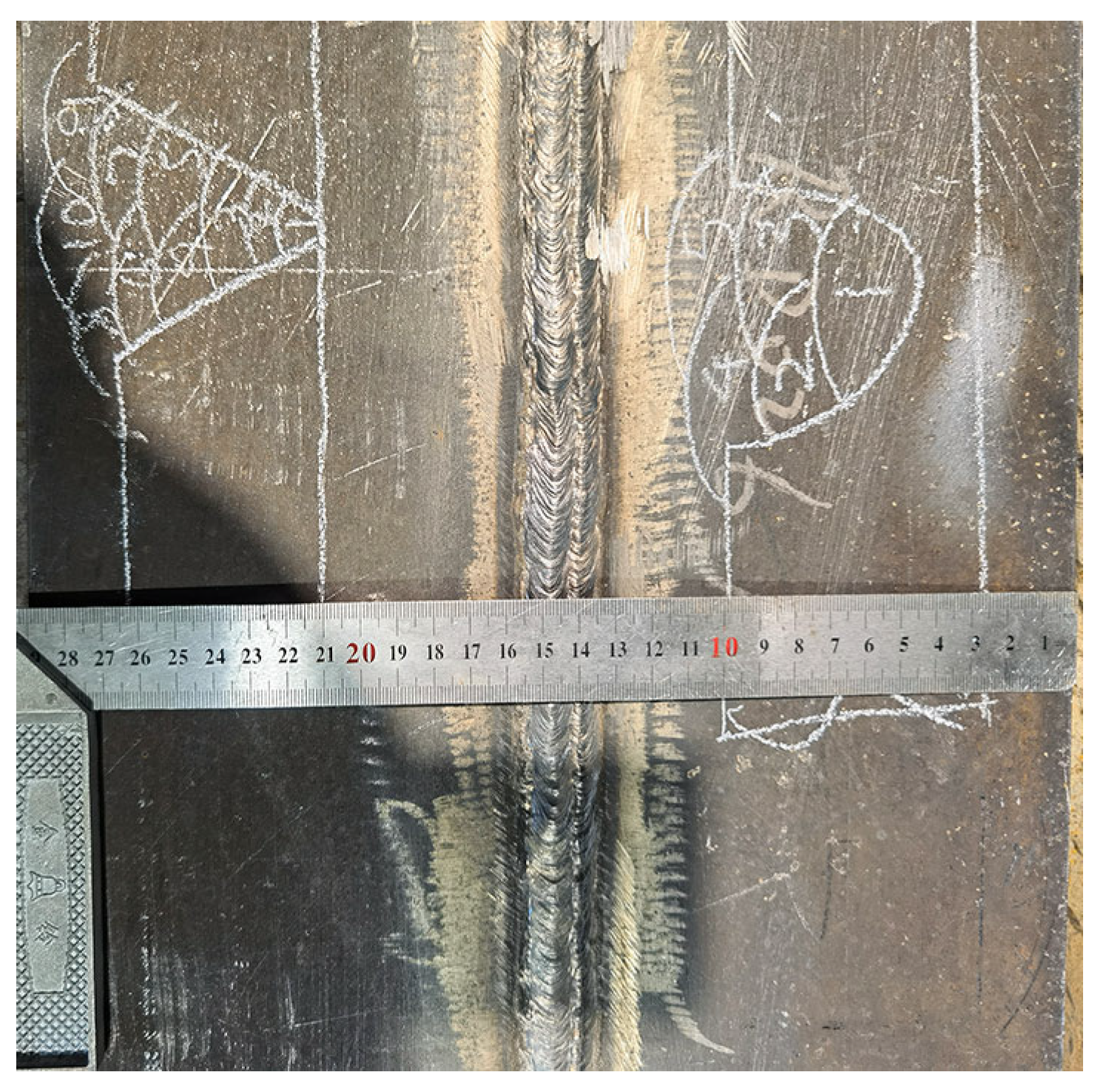
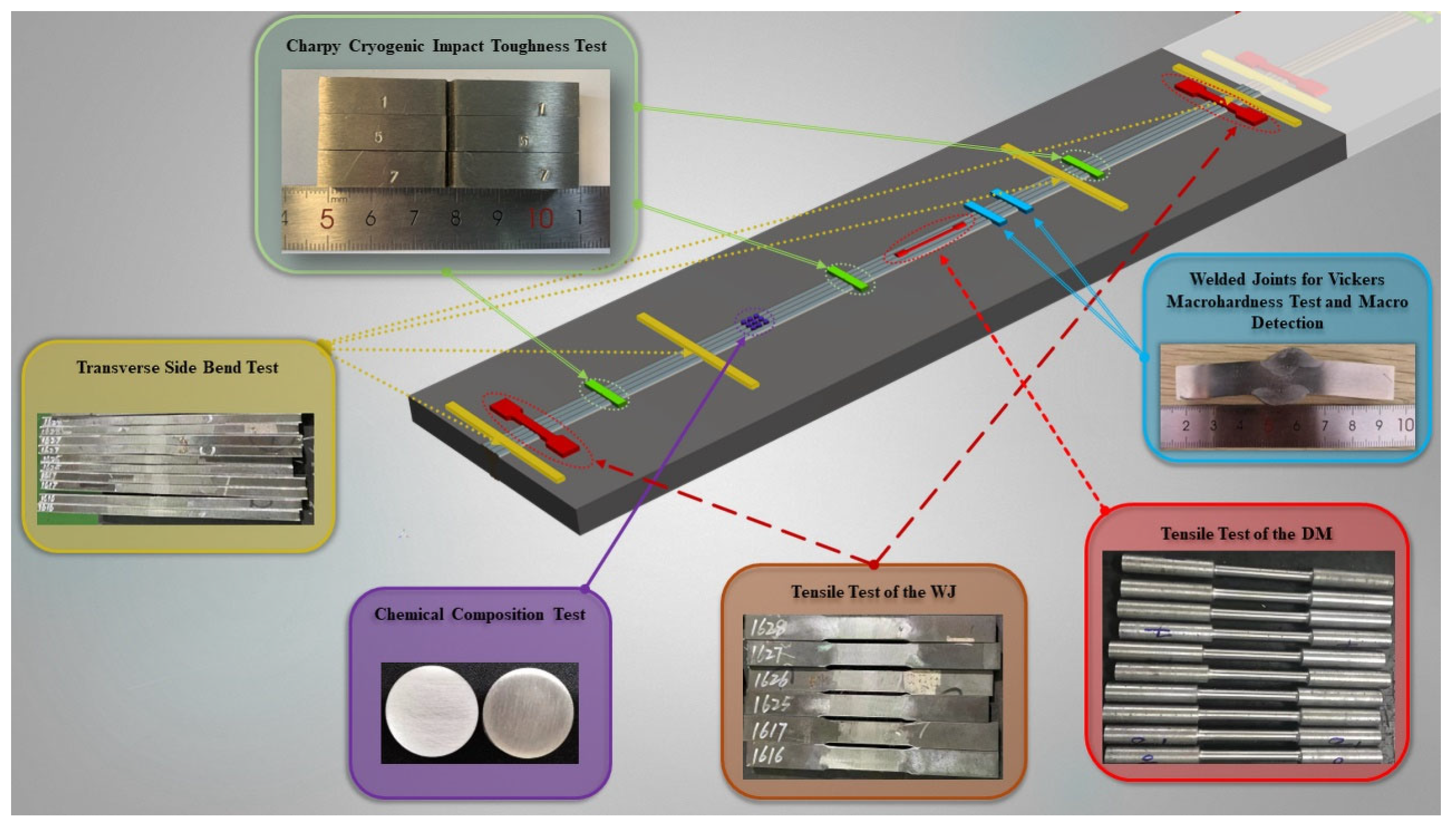

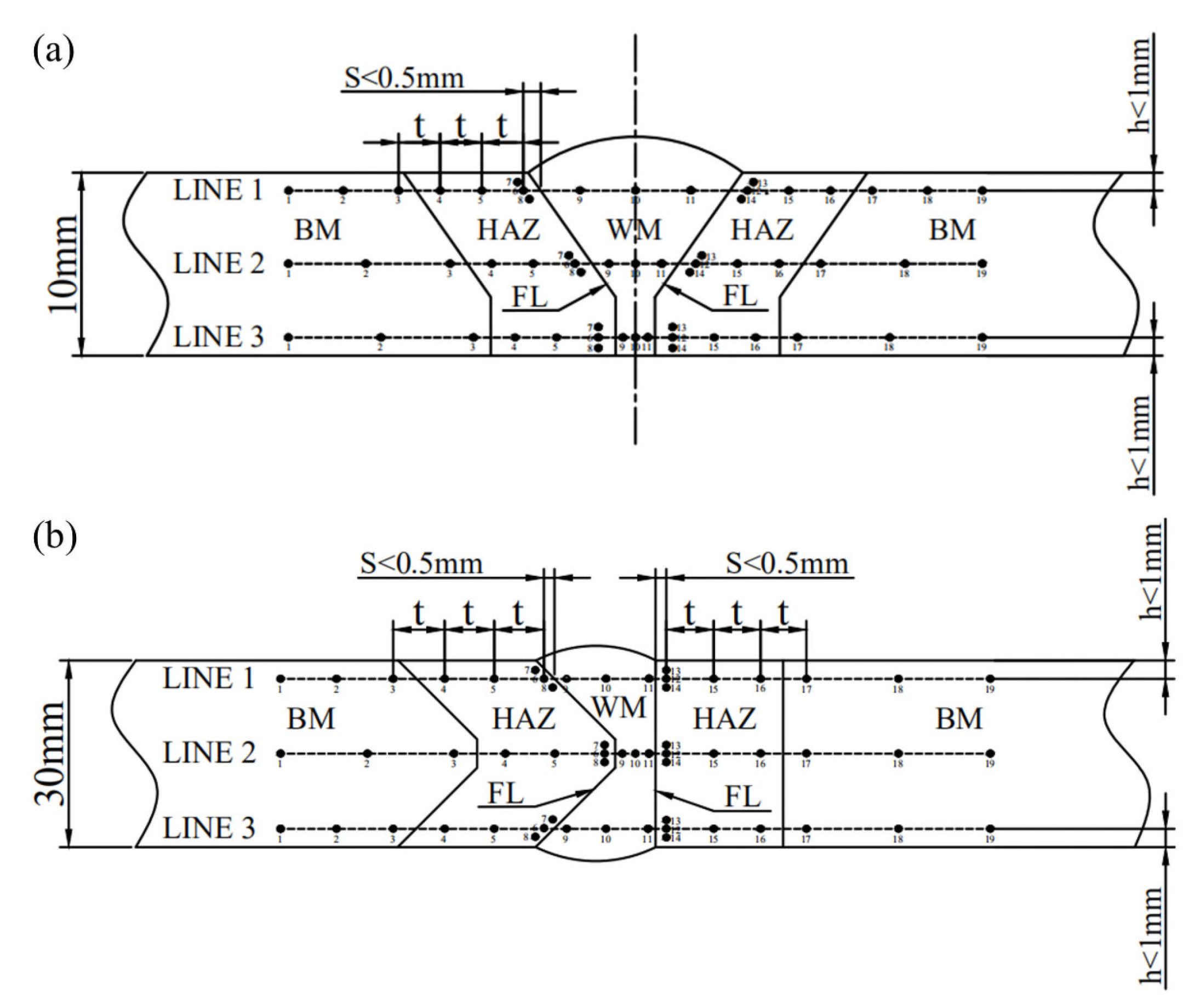
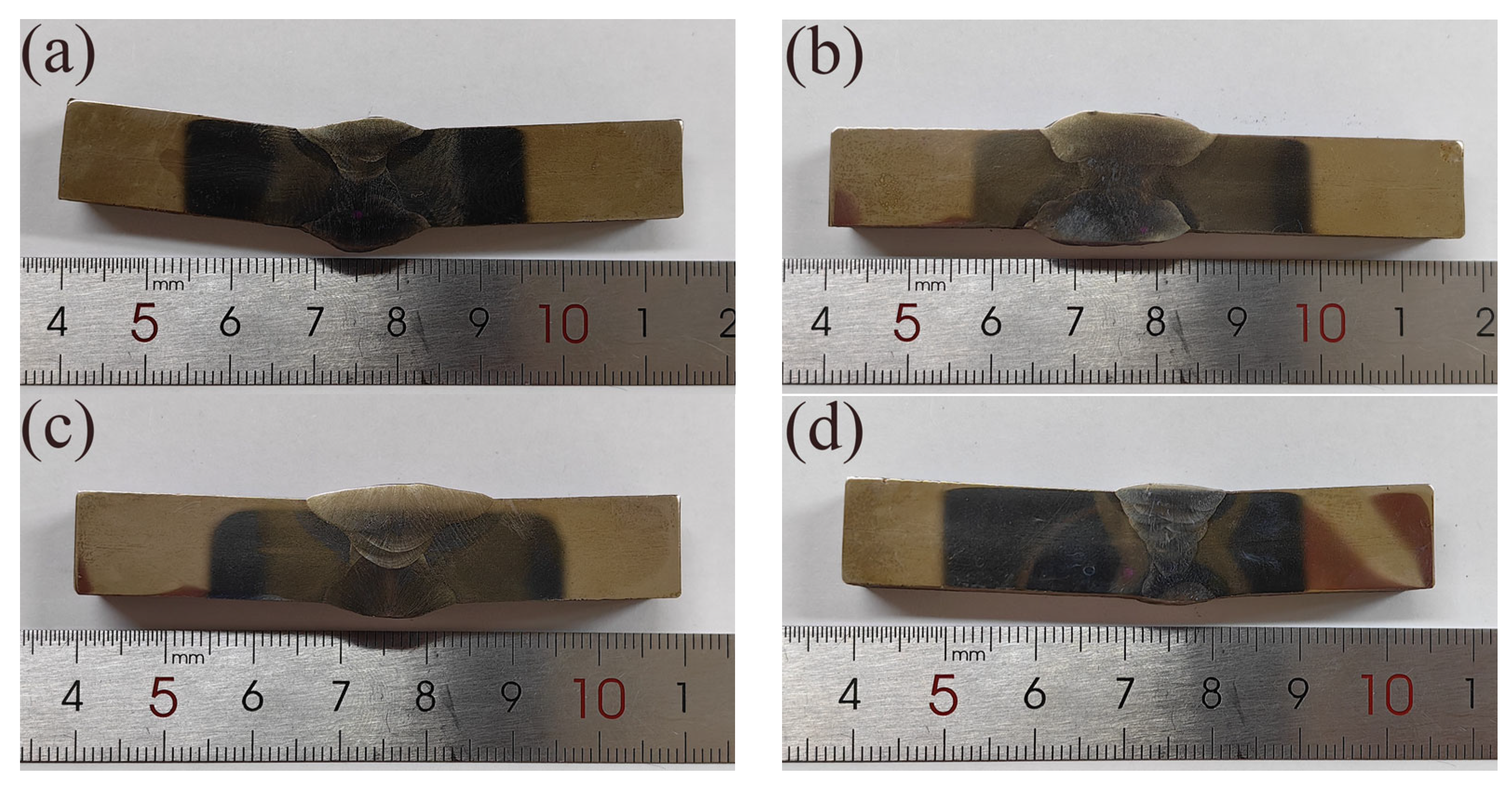

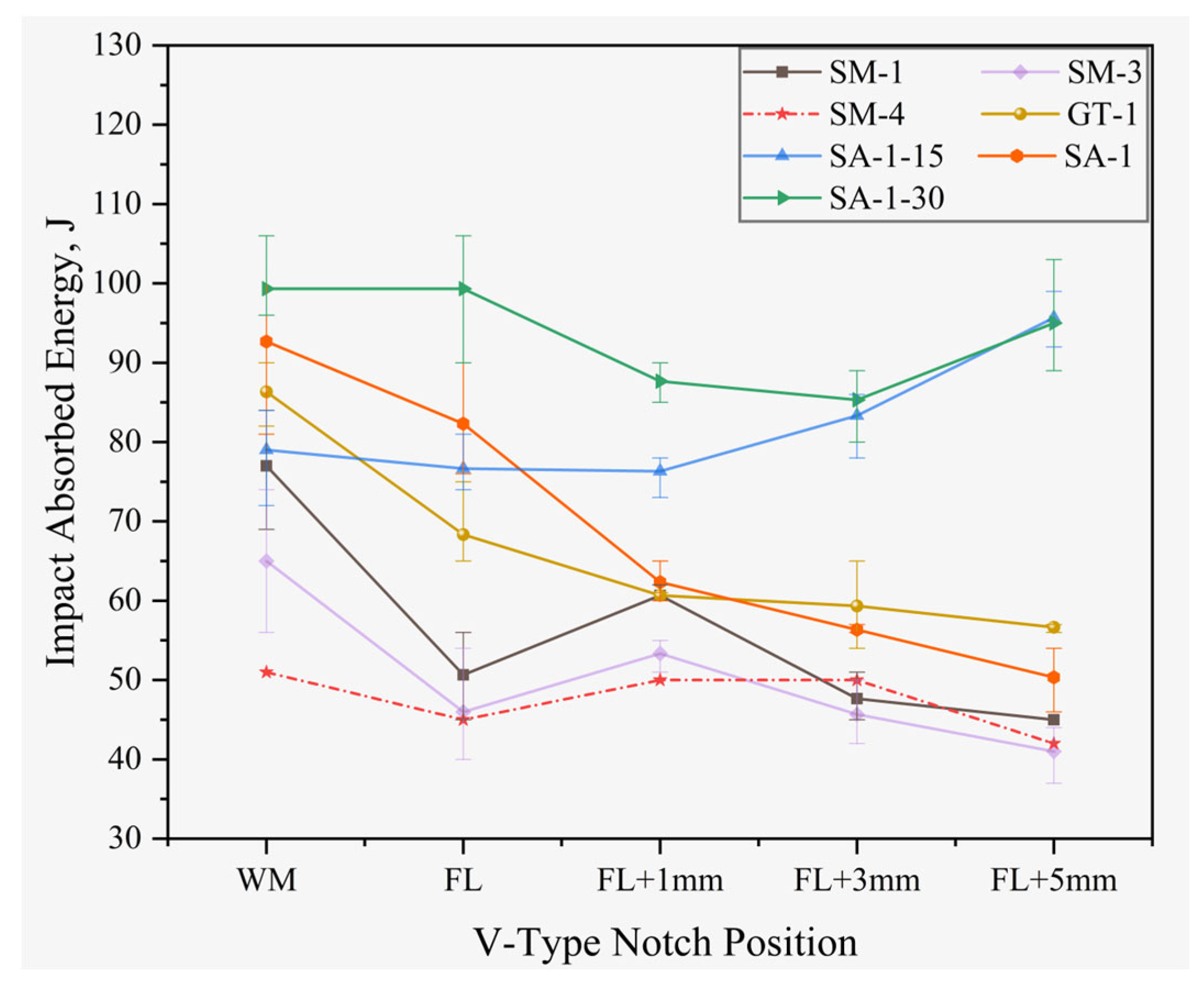
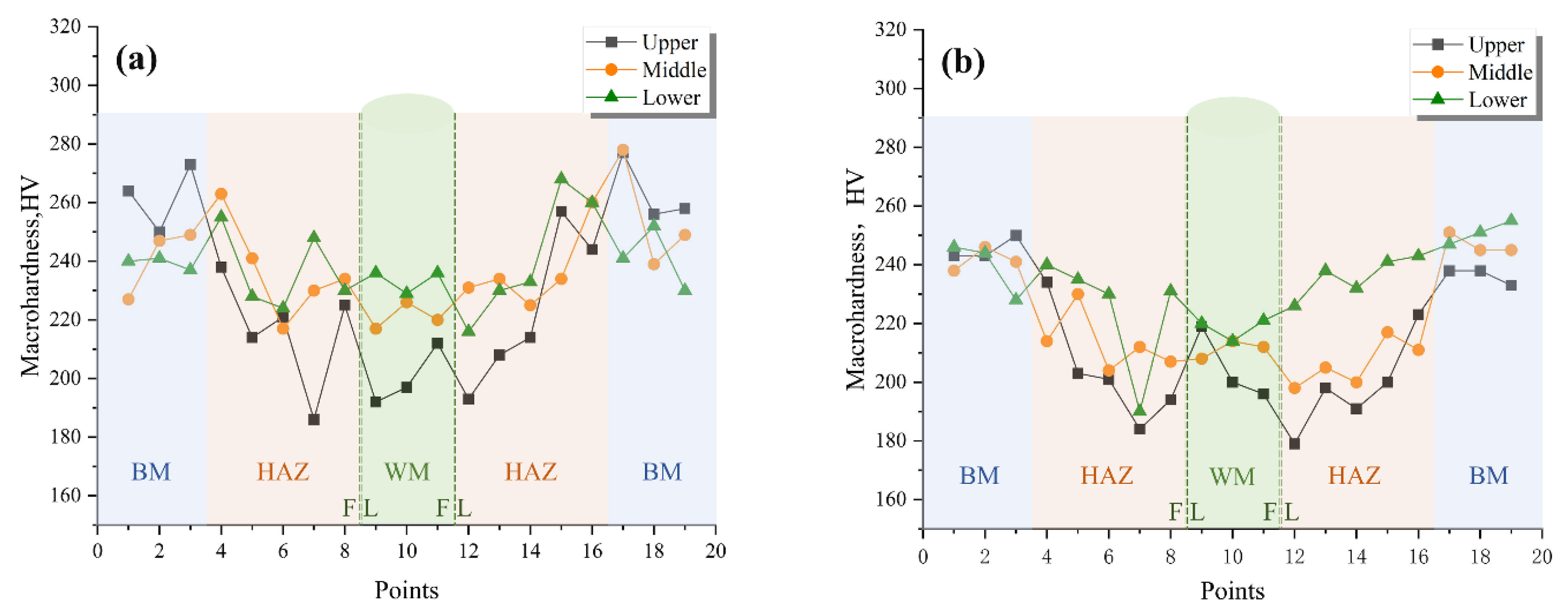
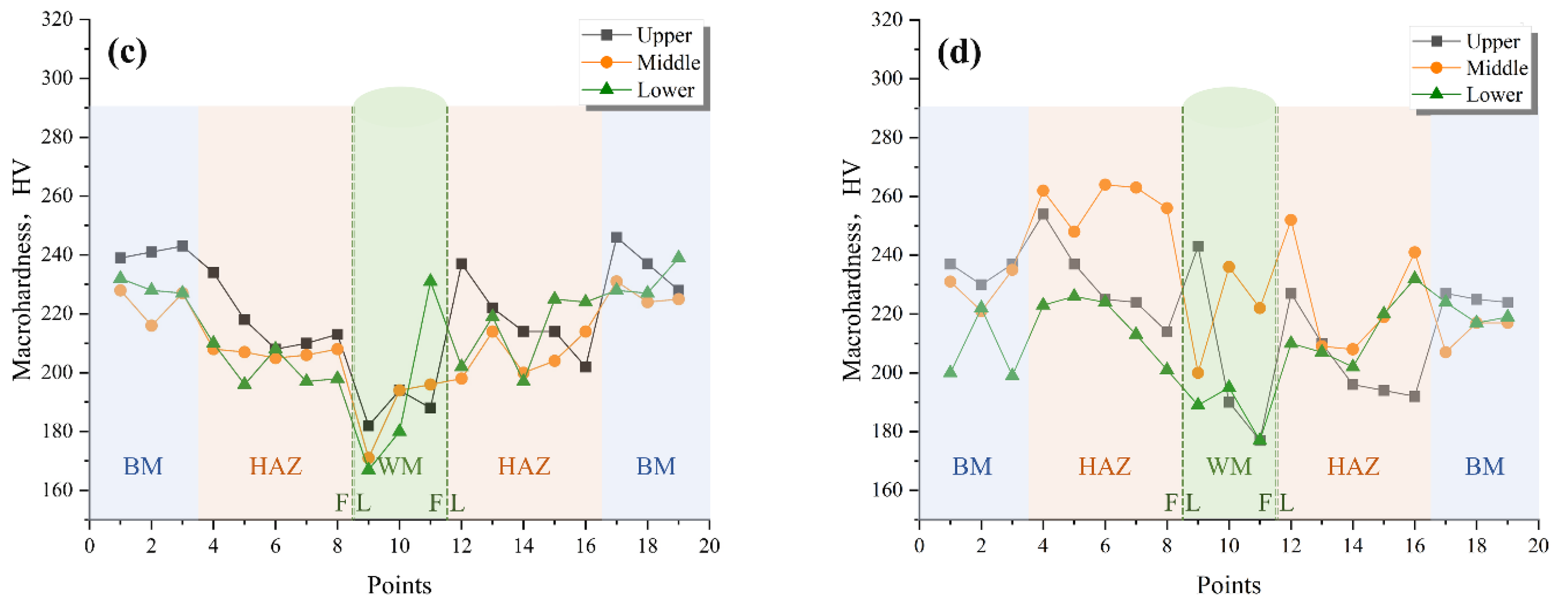
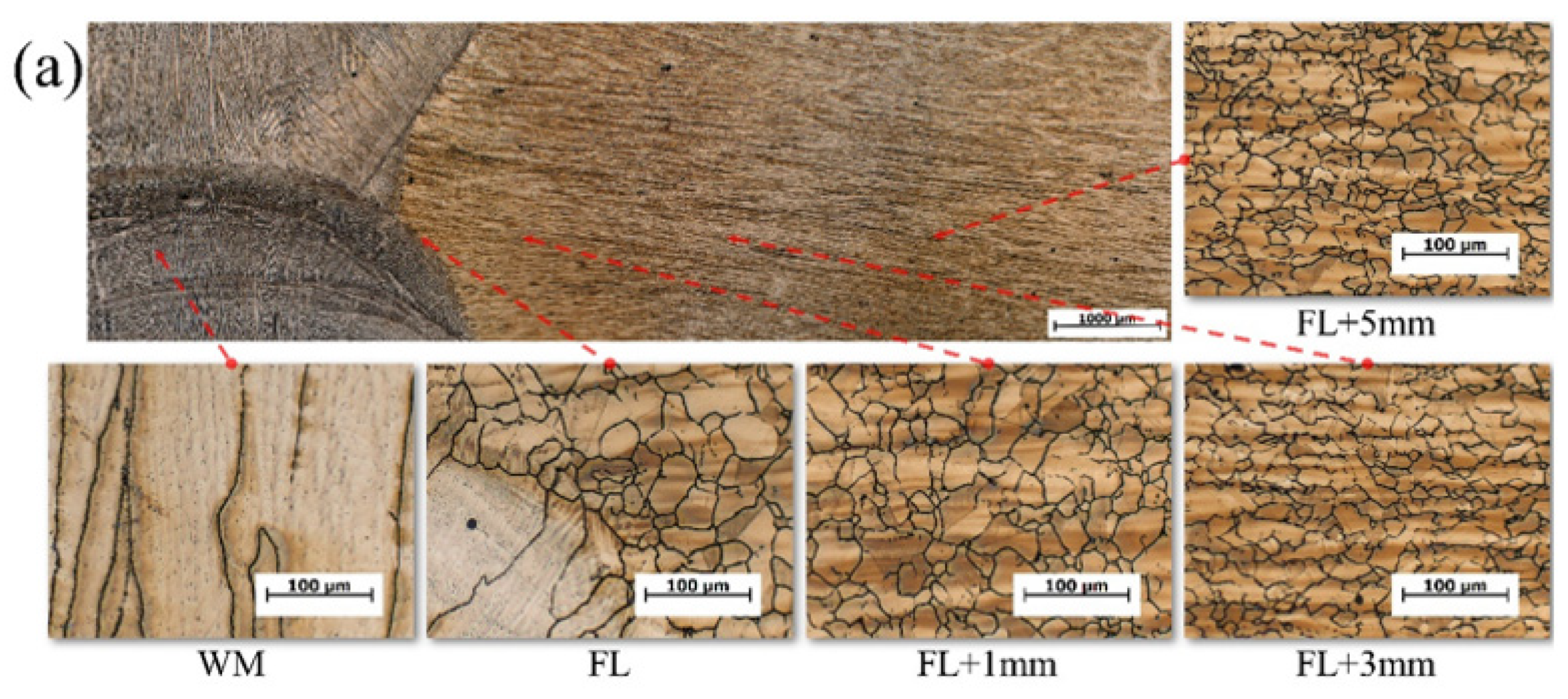
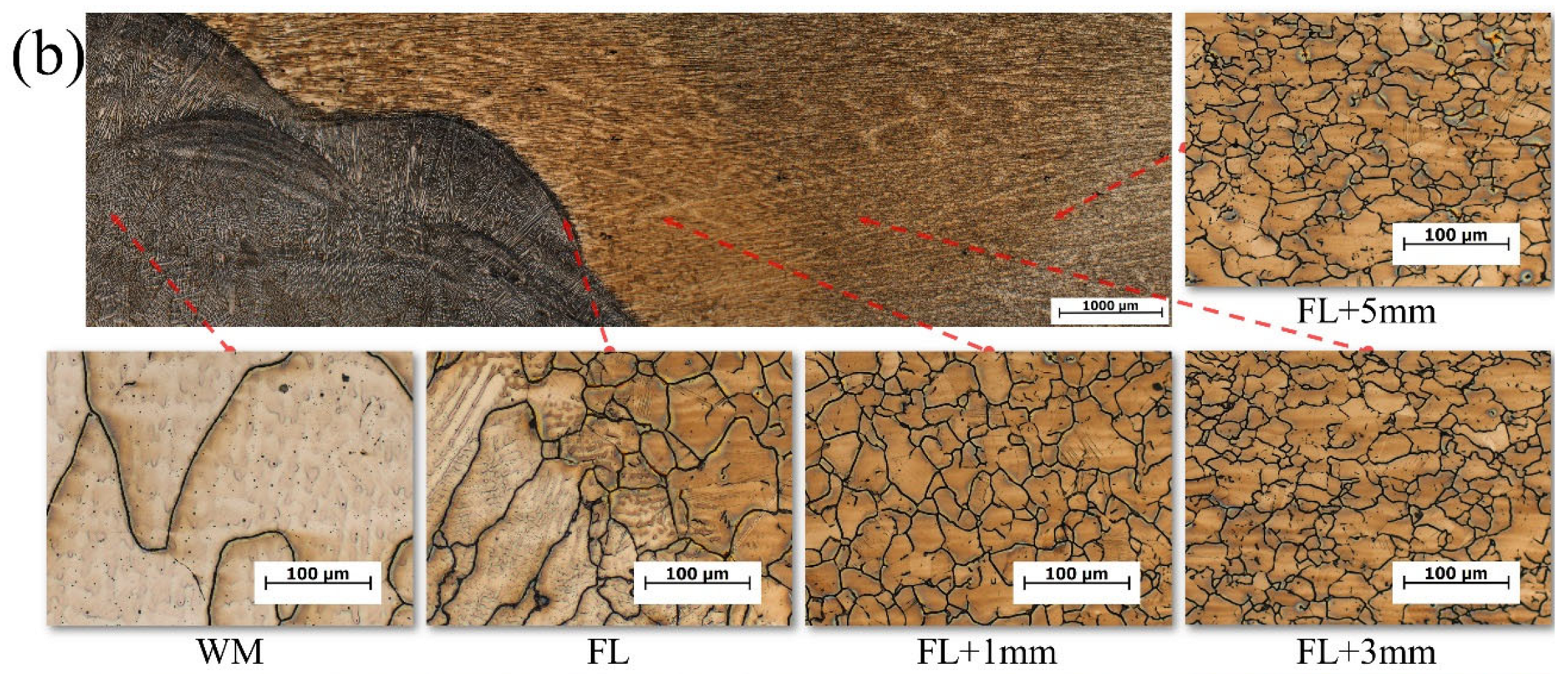
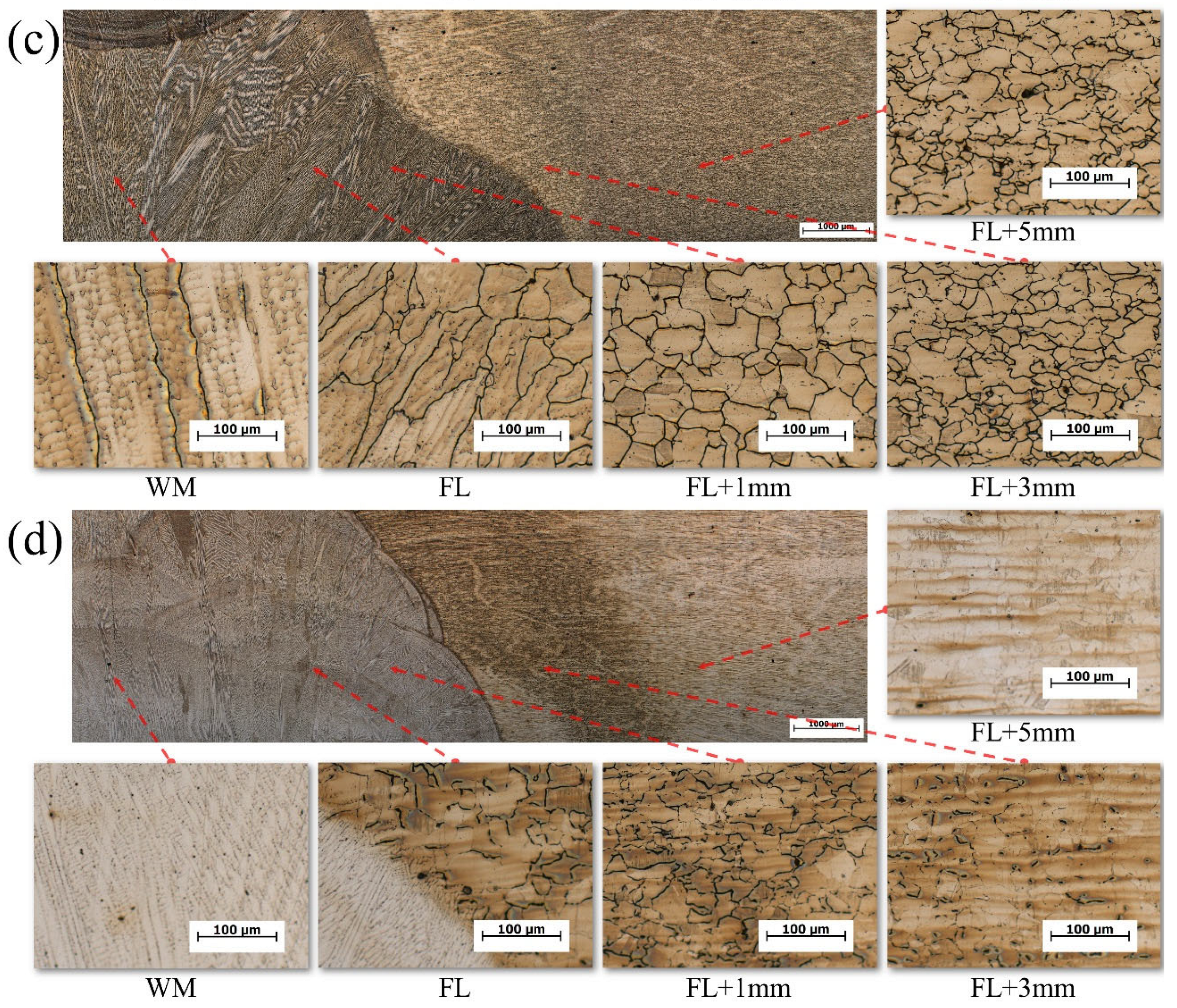
| Test Item | Performance Requirement |
|---|---|
| Yield strength | Weld metal: ≥400 MPa |
| Tensile strength | Weld metal and Welded joint: ≥660 MPa |
| Total elongation | Weld metal: ≥22.0% |
| V-notch Charpy impact test | Average impact absorbed energy at −196 °C: ≥27 J |
| Bending test | Cracks no longer than 3 mm on the tensile surface at 180° bending angle |
| Flaw detection of the weld cross-section | No incomplete fusion, incomplete joint penetration, crack, porosity, and slag inclusions |
| Hardness | ≤350 HV |
| C | Si | Mn | Cr | Cu | P | S |
|---|---|---|---|---|---|---|
| 0.35~0.45 | 0.20~0.25 | 24.50~25.80 | 3.00~5.00 | 0.30~0.70 | ≤0.030 | ≤0.010 |
| Yield Strength (MPa) | Tensile Strength (MPa) | Total Elongation (%) | V-Notch Charpy Impact Absorbed Energy at −196 °C (J) |
|---|---|---|---|
| 402 | 852 | 56.5 | 161 |
| Plate No. | Welding Method and Position | Diameter of Core/Wire (mm) | Current Polarity | Current (A) | Voltage (V) | Travel Speed (cm/min) | Heat Input (kJ/cm) |
|---|---|---|---|---|---|---|---|
| SM-1 | SMAW 1G | 3.2 | DCEP | 92 | 22~26 | 10 | 16 ± 2 |
| SM-3 | SMAW 3G | 3.2 | DCEP | 92 | 20~26 | 7 | 18 ± 2.5 |
| SM-4 | SMAW 4G | 2.5 | DCEP | 70 | 21~24 | 6 | 16 ± 1 |
| GT-1 | GTAW 1G | 2.5 | DCEP | 160 | 11~14 | 9 | 13 ± 2 |
| SA-1 | SAW 1G | 3.2 | DCEP | 430 | 25~33 | 50 | 15 ± 2 |
| SA-1-15 | SAW 1G | 3.2 | DCEP | 430 | 25~33 | 50 | 15 ± 2 |
| SA-1-30 | SAW 1G | 3.2 | DCEP | 550 | 29~33 | 33 | 30 ± 2.5 |
| C | Si | Mn | Cr | Ni | P | S |
|---|---|---|---|---|---|---|
| 0.36~0.40 | 0.06~0.40 | 23.2~24.5 | 2.7~3.3 | 3.9~4.2 | <0.010 | <0.010 |
| Sample No. | Crack | Incomplete Fusion | Incomplete Joint Penetration | Porosity | Slag Inclusions |
|---|---|---|---|---|---|
| SM-1 | No | No | No | No | No |
| SM-3 | No | No | No | No | No |
| SM-4 | No | No | No | No | No |
| GT-1 | No | No | No | No | No |
| SA-1 | No | No | No | No | No |
| SA-1-15 | No | No | No | No | No |
| SA-1-30 | No | No | No | No | No |
| Plate No. | Plate Thickness (mm) | Sample | Yield Strength (MPa) | Tensile Strength (MPa) | Elongation (%) |
|---|---|---|---|---|---|
| SM-1 | 10 | WM | 447 | 760 | 43.9 |
| WJ | — | 764 ± 9 | — | ||
| SM-3 | 10 | WM | 438 | 739 | 39.3 |
| WJ | — | 699 ± 1 | — | ||
| SM-4 | 10 | WM | 440 | 717 | 30.9 |
| WJ | — | 686 | — | ||
| GT-1 | 10 | WM | 469 | 758 | 50.3 |
| WJ | — | 772 ± 8 | — | ||
| SA-1 | 10 | WM | 392 | 691 | 51.5 |
| WJ | — | 708 ± 8 | — | ||
| SA-1-15 | 30 | WM | 549 | 882 | 44.5 |
| WJ | — | 764 ± 8 | — | ||
| SA-1-30 | 30 | WM | 565 | 764 | 33.0 |
| WJ | 754 ± 11 |
| Plate No. | WM (J) | FL (J) | FL + 1 (J) | FL + 3 (J) | FL + 5 (J) | ||||||||||
|---|---|---|---|---|---|---|---|---|---|---|---|---|---|---|---|
| SM-1 | 78 | 84 | 69 | 56 | 45 | 51 | 60 | 62 | 60 | 45 | 51 | 47 | 45 | 45 | 45 |
| 77 ± 6 * | 51 ± 4 * | 61 ± 1 * | 48 ± 2 * | 45 ± 0 * | |||||||||||
| SM-3 | 56 | 65 | 74 | 44 | 40 | 54 | 51 | 54 | 55 | 45 | 42 | 50 | 37 | 44 | 42 |
| 65 ± 7 * | 46 ± 8 * | 53 ± 2 * | 46 ± 3 * | 41 ± 3 * | |||||||||||
| SM-4 | 51 | 45 | 50 | 50 | 42 | ||||||||||
| GT-1 | 82 | 87 | 90 | 65 | 65 | 75 | 61 | 61 | 60 | 59 | 65 | 54 | 57 | 57 | 56 |
| 86 ± 3 * | 68 ± 5 * | 61 ± 0 * | 59 ± 4 * | 57 ± 0 * | |||||||||||
| SA-1 | 91 | 81 | 106 | 81 | 90 | 76 | 62 | 65 | 60 | 56 | 56 | 57 | 54 | 46 | 51 |
| 93 ± 10 * | 82 ± 6 * | 62 ± 2 * | 56 ± 0 * | 50 ± 3 * | |||||||||||
| SA-1-15 | 81 | 84 | 72 | 74 | 81 | 75 | 73 | 78 | 78 | 86 | 86 | 78 | 92 | 96 | 99 |
| 79 ± 5 * | 77 ± 3 * | 76 ± 2 * | 83 ± 4 * | 96 ± 3 * | |||||||||||
| SA-1-30 | 106 | 96 | 96 | 90 | 102 | 106 | 85 | 90 | 88 | 87 | 80 | 89 | 103 | 93 | 89 |
| 99 ± 4 * | 99 ± 7 * | 88 ± 2 * | 85 ± 4 * | 95 ± 6 * | |||||||||||
| Plate No. | Sample Number | Thickness (mm) | Bend Diameter (mm) | Bend Angle (°) | Result |
|---|---|---|---|---|---|
| SM-1 | 4 | 10 | 40 | 180 | No opening defects after test |
| SM-3 | 4 | 10 | 40 | 180 | No opening defects after test |
| SM-4 | 4 | 10 | 40 | 180 | No opening defects after test |
| GT-1 | 4 | 10 | 40 | 180 | No opening defects after test |
| SA-1 | 4 | 10 | 40 | 180 | No opening defects after test |
| SA-1-15 | 4 | 10 | 40 | 180 | No opening defects after test |
| SA-1-30 | 4 | 10 | 40 | 180 | No opening defects after test |
| Test Item | Requirement | SM-1 | SM-3 | SM-4 | GT-1 | SA-1 | SA-1-15 | SA-1-30 |
|---|---|---|---|---|---|---|---|---|
| Yield strength of WM | ≥400 MPa | 447 MPa | 438 MPa | 440 MPa | 469 MPa | 392 MPa | 549 MPa | 565 MPa |
| Tensile strength of WM | ≥660 MPa | 760 MPa | 739 MPa | 717 MPa | 758 MPa | 691 MPa | 882 MPa | 764 MPa |
| Total elongation of WM | ≥22% | 43.9% | 39.3% | 30.9% | 50.3% | 51.5% | 44.5% | 33.0% |
| Tensile strength of WJ | ≥660 MPa | 764 ± 9 MPa | 699 ± 1 MPa | 686 MPa | 722 ± 8 MPa | 708 ± 8 MPa | 764 ± 8 MPa | 754 ± 11 MPa |
| V-notch Charpy impact test | ≥27 J | 45–84 J | 37–74 J | 42–52 J | 54–90 J | 46–106 J | 72–99 J | 85–106 J |
| Hardness | ≤350 HV | ≤280 HV | ≤256 HV | ≤253 HV | ≤264 HV | ≤248 HV | ≤275 HV | ≤263 HV |
Disclaimer/Publisher’s Note: The statements, opinions and data contained in all publications are solely those of the individual author(s) and contributor(s) and not of MDPI and/or the editor(s). MDPI and/or the editor(s) disclaim responsibility for any injury to people or property resulting from any ideas, methods, instructions or products referred to in the content. |
© 2023 by the authors. Licensee MDPI, Basel, Switzerland. This article is an open access article distributed under the terms and conditions of the Creative Commons Attribution (CC BY) license (https://creativecommons.org/licenses/by/4.0/).
Share and Cite
Zhang, S.; Wang, H.; Wang, Y.; Cao, L. Study on the Novel High Manganese Austenitic Steel Welded Joints by Arc Welding for Cryogenic Applications of LNG Tanks. Materials 2023, 16, 2381. https://doi.org/10.3390/ma16062381
Zhang S, Wang H, Wang Y, Cao L. Study on the Novel High Manganese Austenitic Steel Welded Joints by Arc Welding for Cryogenic Applications of LNG Tanks. Materials. 2023; 16(6):2381. https://doi.org/10.3390/ma16062381
Chicago/Turabian StyleZhang, Shuchang, Honghong Wang, Yangwen Wang, and Liang Cao. 2023. "Study on the Novel High Manganese Austenitic Steel Welded Joints by Arc Welding for Cryogenic Applications of LNG Tanks" Materials 16, no. 6: 2381. https://doi.org/10.3390/ma16062381
APA StyleZhang, S., Wang, H., Wang, Y., & Cao, L. (2023). Study on the Novel High Manganese Austenitic Steel Welded Joints by Arc Welding for Cryogenic Applications of LNG Tanks. Materials, 16(6), 2381. https://doi.org/10.3390/ma16062381




